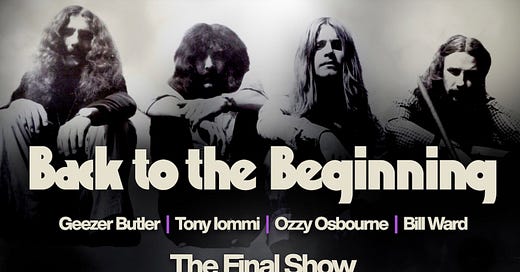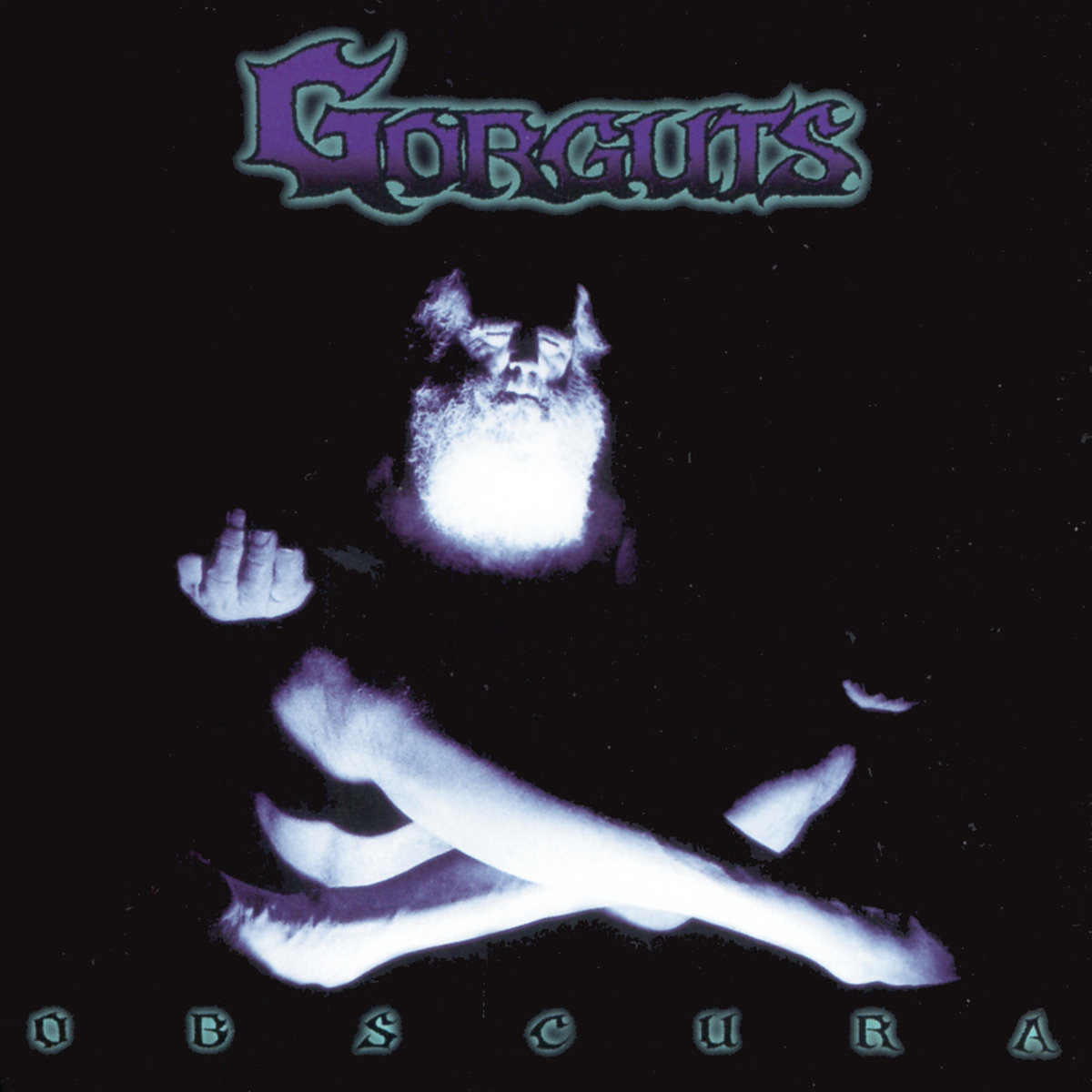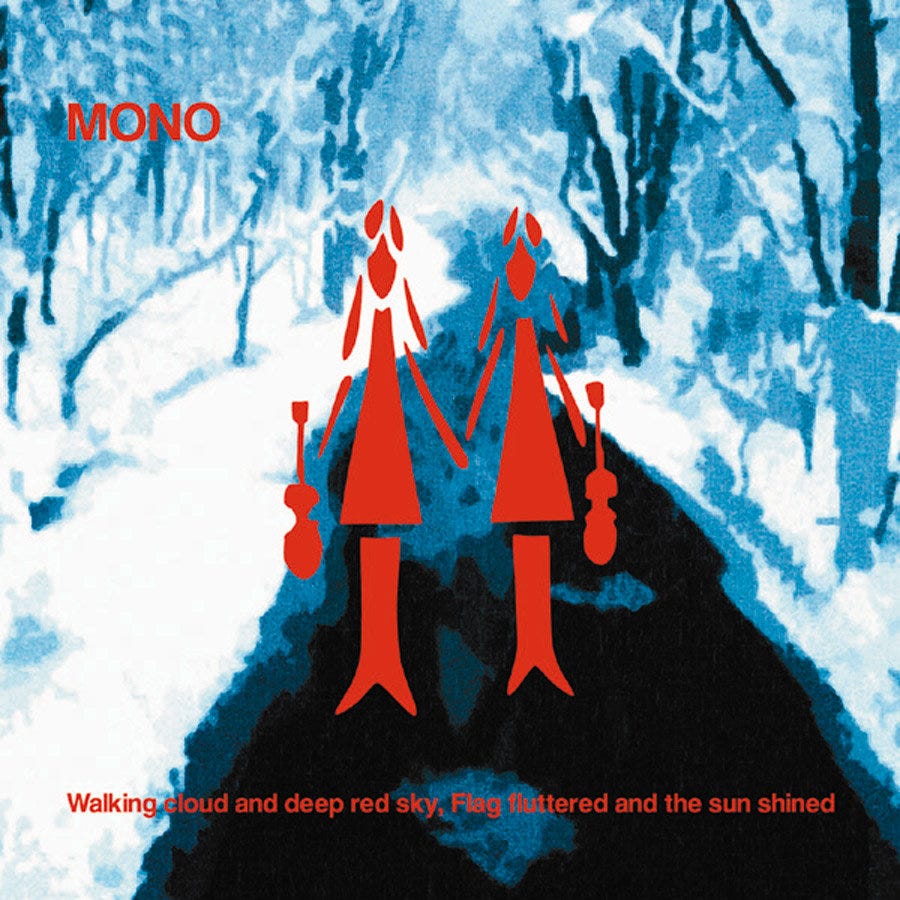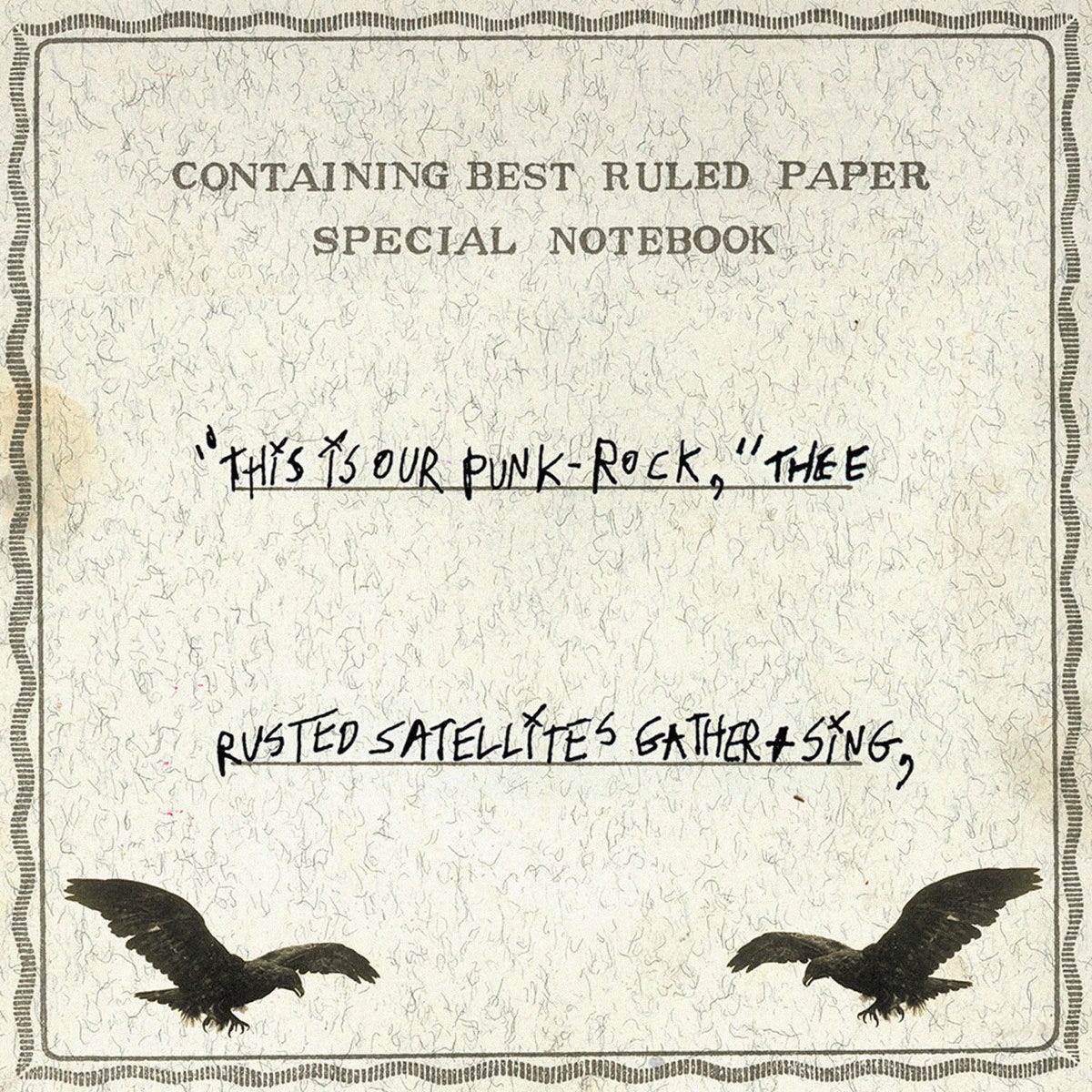On February 5th metalheads the world over logged on to the internet and asked in their local dialect some equivalent to the question “what is *this* that stands before me?”. This eternal hesher query was prompted by the image below, a poster for what claims to be the final show in Ozzy Osbourne’s long career, featuring a reunion with the original Black Sabbath lineup, including long estranged drummer Bill Ward. Directly below Sabbath on the show poster are a who’s who of their musical progeny filling out the rest of the lineup. But don’t let me spoil it for you, take a look for yourselves. Here’s the poster as it was premiered on 2/5/25:
Yowza! Since its first publication the lineup has only gotten more stacked, adding sets from Tool and Guns N’ Roses. It will not surprise you to learn that tickets sold out instantly.
This event is remarkable for several reasons. It is rare that a genre of music gets to throw a retirement party for one of its founding members. Though heavy metal does not have as definitive a birthday as say, hip-hop, the neat and tidy version of the story is that the genre began in earnest with the release of Black Sabbath’s self-titled debut on February 13th, 1970. Even if you have an alternative heavy metal day one in mind, there is no version of the genre’s history that doesn’t account for Black Sabbath’s impact. The seeds for almost every kind of heavy metal imaginable can be found in the string of eight albums that Ozzy Osbourne recorded with Sabbath throughout the 70s. Even in today’s djentrified modern metal scene we see the legacy of Tony Iommi tuning down his guitar after his fretting hand was injured in a work accident1. Having the chance to celebrate the achievements and legacy of a figure so central to heavy metal as Ozzy Osbourne is a luxury that fans should not take for granted. One need only contemplate the names that could not corporally participate in hip-hop’s 50th birthday party to appreciate the chance to honor Osbourne while we can.
Even more contested than heavy metal’s origins is the status of its extensive family tree. Sorting out who belongs and why is one of metal culture’s favorite rituals. This concert is the closest we’ll have to a definite answer from the genre’s forefathers about the subject. If metal’s pharaoh is retiring to his chambers, this poster tells us who else is getting buried in the pyramid with him. Obviously there are other factors involved in selecting the bill like availability and marketability (i.e. who’s going to help us sell tickets), but I’d much rather interpret this collection of acts on an aesthetic basis. I think you can break down the bill into a few discrete categories by decade:
The 1970s (Black Sabbath’s Contemporaries): Outside of former Judas Priest guitarist KK Downing this category is nearly empty. No Judas Priest proper, certainly no Iron Maiden (do they still harbor a grudge from Ozzfest 06?) and sadly no Motorhead. Sabbath themselves stand as the lone speaker for 70s heavy metal.
The 1980s (Thrash vs Glam): Here we have the first branching path in metal’s lineage, implying the eternal struggle between the “real” and the “false”. On one end we have three of the legendary “Big 4” of American thrash, represented by Metallica, Slayer, and Anthrax. Dave Mustaine was presumably too busy doing Jesus stuff for Megadeth to perform. These acts draw a direct line from Sabbath’s faster material, like “Paranoid”, “Children of the Grave” or “Symptom of the Universe”. On the other side we have a smattering of 80s hair bands like Guns N Roses along with two members of Van Halen. These bands are justified by the presence of Ozzy Osbourne’s solo band which traded in the same “big hair and bigger ballads” philosophy that energized the sunset strip in metal’s mainstream heyday.
The 1990s (Alternative Nation): Here’s where things start getting a little chaotic. On one hand we have racist zombie Pantera, who sold outrageous amounts of records in the 90s when the rest of the scene was largely dead and their two most important founding members were alive (and racist). If Pantera stood alone as the only commercially successful “real” metal band in the 90s this bill retroactively canonizes much of their “false” competition. Some of these inclusions are long overdue. Despite being lumped into the grunge scene Alice in Chains were always more of a metal band at heart. With nü-metal officially revived and critically reconsidered it’s only natural that the singers of Korn and Limp Bizkit make an appearance to pay their (dis)respects to the old ways. Tool don’t fall neatly into any sub-genre, having emerged in the 90s alt rock explosion before embracing the dark magic of Prog in the 00s, but their impact on modern metal demands their recognition here. Fellow alt rockers Faith No More are grandfathered into real metal via their shared DNA with Ozzy’s solo band. Tom Morello is incapable of not showing up at star studded rock events, and the inclusion of Rage Against The Machine balances out at least some of Pantera’s bad vibes. Despite their sonic and political disagreements, this crowd all owe their low-tuned midtempo stomp to the doomy blues perfected on Sabbath’s first six albums. I can offer no explanation for Billy Corgan, however.
The 2000s (“Modern” Metal): After a decade in the wilderness, the story goes, “real” metal returned to the forefront with the New Wave of American Heavy Metal in the 00s. Mastodon and Lamb of God, fresh off their co-headlining tour celebrating the 20th anniversaries of their career making albums Ashes In The Wake and Leviathan stand in for that moment here. Absent are their contemporaries in the metalcore scene like Killswitch Engage of Shadows Falls. Instead they’re joined by nü-metal latecomers Disturbed and French eco-enthusiasts Gojira. Gojira and Lamb of God are the only bands on this bill to frequently use harsh vocals and thus represent the whole of the extreme metal scene at this event. Their connection to Black Sabbath is more abstract, as they instead draw inspiration from the intervening strains of underground metal that iterated on the classic sound.
The 2010s (Actual Modernity): I’m going to be honest. I’ve never once heard a Halestorm song, and have never had a single conversation with a person in real life in which they were ever mentioned. They’re like the metal equivalent of H.E.R., an act that exists entirely within the industry apparatus who’s real world popularity feels like a complete fabrication. It blows my mind that they’re booked over Ghost, who are a legit huge band with songs that will get stuck in your head whether you like them or not. Both bands however are only modern in the strictly temporal sense. Neither play anything close to modern rock, instead basing their sound on 70s & 80s arena rock. The burden of the new falls entirely on the shoulders of a sole member of Sleep Token. Good luck, buddy!
As for the omissions, there are several that stick out to me. There are the big names I mentioned earlier like Iron Maiden and Judas Priest as well as the many smaller names left out by the complete dismissal of death metal and black metal. The big names of progressive metal, Dream Theater and Opeth, are also left out of the cold unless they have the meat-head appeal of Tool and Mastodon. But most striking is the absence of any band anointed as a successor to Sabbath’s doom metal legacy. No Sleep, no Candlemass, not even Uncle Acid. If you want a seat at the funeral, you have to earn your way there on your own aesthetic merits.
Did I say funeral? That might strike some readers as unnecessarily morbid, but be honest with yourselves. Since the first tritone rung out of Iommi and Butler’s amplifiers heavy metal has been obsessed with death. The song that got this whole party started was about fearing for your life and fleeing from the dark hand of fate. Now that pointing figure in black has finally caught up. Considering that Osbourne retired from touring in 2023 due to his health struggles with Parkinson’s I do not expect this curtain call to be a false alarm. For the same reasons I also do not expect Black Sabbath’s performance to be particularly good, though it will likely be moving in a way that few metal concerts have ever had the opportunity to be. After all the bluster, the fire and skulls and screams and what not, here is a real chance for heavy metal as a genre and a sub-culture to reckon with it’s own mortality.
~ ~ ~ ~ ~ Listening Diary ~ ~ ~ ~ ~
“Celestial Chant” by McCoy Tyner (Trident, 1975)
I added a bunch of McCoy Tyner records to my queue after reading about them in Burning Ambulance. Shuffle decided that this was the week I’d listen to them. No complaints, the guy was a genius! As I mentioned in this month’s Playlist Postscript Elvin Jones is probably my favorite jazz drummer, mostly for his contributions to John Coltrane’s records. It’s great to hear him and bassist Ron Carter keep the groove going with Tyner at the helm, but what really makes these records pop is their adventurous arrangements. Though the trio’s method is straightforwardly jazzy, Tyner adds unconventional instruments like harpsichord and celeste to the mix, giving the jam an otherworldly, dreamlike ambience.
“XI” by João Pais Filipe (Sun Oddly Quiet, 2020)
This track came my way via the Death // Sentence Discord channel. Again, Discord is the real social media these days. If you want a pipeline to the good, weird stuff find yourself a niche community of fellow weirdos and start sharing links. Should I make a Lamniformes Discord channel? I’m pretty sick of Instagram these days and would love an excuse to hangout somewhere else. Anyway, this is some percussion-centric drone, great background productivity music if you need it and fascinating on its own as a work of percussion.
“Listless Dream (Extended Remix)” by Yura Yura Teikoku (REMIX 2005-2008, 2008)
Here’s another Discord find, this one coming directly from Tim Rogers himself in the Action Button Discord. In case you’re wondering, no you do not need to hear the original mix to enjoy this extended version. The original’s fine, but it doesn’t have any of the looping, octave-doubled guitar lines that make this mix so mind-blowing.
“Electric Boogies” by Electric Boogies (Onda de Amore: Synthesized Brazilian Hits That Never Were (1984-94), 2018)
A deep cut from a compilation of deep cuts. This mostly wordless jam replicates the breezy complexity of Brazilian jazz fusion on charmingly old school synths and drum machines. This may seem like a somewhat obvious observation, but once you get past the instrumentation and focus on the music being “played” a lot of electronic music reveals itself to be no different than fusion. I’d love to hear a band rip this live, but the keyboard version is no less slick for it’s digital sound sources.
“Survival Blues” by McCoy Tyner (Extensions, 1973)
More Tyner, this time expanding the trio to include Wayne Shorter and Alice Coltrane. Again I’m stunned by this group’s absolute mastery of jazz fundamentals and then the daring choices they make framing that mastery. It’s remarkable how much the presence of a harp changes the experience of jazz. Coltrane fluttering up out of nowhere after Elvin Jones’ drum solo is magical stuff.
\ \ \ \ \ Micro Reviews / / / / /
Here are five micro reviews of albums from my vast Rate Your Music catalog. Long time Lamniformes Instagram followers will recognize these from my stories, however they’ve been re-edited and spruced up with links so that you can actually hear the music instead of just taking my word for it.
Obscura by Gorguts (1998) - Death Metal
I’ve mentioned in these reviews before that when I was high school the “cool” death metal bands to cite were the more refined end of the Florida scene (Death, Cynic, Atheist). Well, by the time I was in college that hipness had slid north to the French-Canadian Gorguts and this album in particular. Death metal is already pretty weird music when it’s standard issue, chromatic, loud, and lopsided, but Gorguts were anything but standard when this dropped. Whole tone scales, jazz harmony, extended guitar technique, and more all revved up to death metal velocity. More importantly, Gorguts craft genuinely memorable songs out of these challenging ingredients. The only problem is that at an hour long it’s a lot to take in during one sitting. I’d recommend taking a break after “Clouded” so that the second half doesn’t blur together.
Walking Cloud and Deep Red Sky, Flag Fluttered and the Sun Shined by Mono (2004) - Post-Rock
The first album I checked out after getting my brain rearranged by Mono when they opened for Pelican, and Mono’s first album with Steve Albini. You can see why an instrumental post rock quartet would link up with Albini, if your music is all about going from very quiet to very loud you might want to work with a guy who knows a thing or two about dynamic range. Mono get mighty loud on this record. Sometimes you can see it coming a mile away, sometimes Mono will genuinely surprise you, but the crescendo will always arrive. What makes this album good despite its heavy-handedness is Mono’s superb ear for melody and Takeda Yasunori’s feel on the drums. The climax of “Lost Snow” will clean out your sinuses too, so don’t mistake this for some weepy hope-core pushover.
The Phoenix Tree by Mono (2007) - Post-Rock
A four track EP Released as part of the Travels in Constants series on Temporary Residence Records. Might be the ideal starting place for someone looking to get into Mono, since it features their orchestral side and their “pulverize you with loud guitars” side all in a digestible length. You’re probably wondering about that album art. Well, despite being an instrumental record the titles and art point to this album being about the nuclear bomb. Heavy stuff, especially considering that Mono are Japanese. But hey, you wouldn’t want to listen to a post rock band that weren’t trying to make you feel big complicated feelings, right?
“This Is Our Punk Rock,” Thee Rusted Satellites Gather + Sing by The Silver Mt. Zion Memorial Orchestra & Tra-La-La Band with Choir (2003) - Post-Rock
Good lord is it it a pain to type out this band’s name and album titles. Listening to them however is always a pleasure. A song-based offshoot of Godspeed You! Black Emperor, though in this case the songs are quite long and droning enough to be mistaken for the main act. The real difference is the focus on live singing, often in group harmony though sometimes nakedly solo. This record is less explosive than your typical post rock record, the point is in the way the songs drift in and out of white noise. Track three “American Motor Over Smoldered Fields” is the gem of the bunch, sporting more ornate harmony and structural momentum.
“He Has Left Us Alone But Shafts of Light Sometimes Grace the Corners of Our Rooms” by A Silver Mount Zion (2000) - Post-Rock
The first record from ASMT. Apparently one of the songs on this record went semi-viral on TikTok in the last few years? Can’t say that really surprises me because post rock is definitely for the teens (this is a compliment). That said, it’s hard to call this a rock album of any stripe as its mostly piano and strings, produced with the blown out apocalyptic reverb you’d expect from a Godspeed-related project. Usually this family of bands make their hay with maximalism, more instruments! long songs! extraneous punctuation!, but this album works because of its restraint. I prefer the band’s later, more rocking’ material, but this album is very pretty and hits the spot if you want more mournful instrumental music in your life.
Will the offending machinery get brought up on stage for a proper tribute? One can only hope. Maybe it’ll get a chance to finish the job.










The tribute concert seems to be a trend - had similar hippie country (Willie Nelson) and folk (Joni Mitchell) concerts/celebrations in LA in the past couple years. Great piece as always.
A comment from somewhere I saved to a commonplace book txt file seems germane here:
"It's OK that rock is dead. Fifty years on top is a HELL of a run. Jazz didn't even have that."